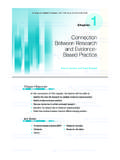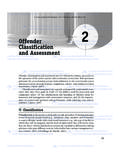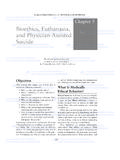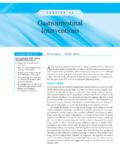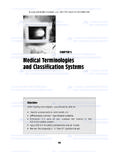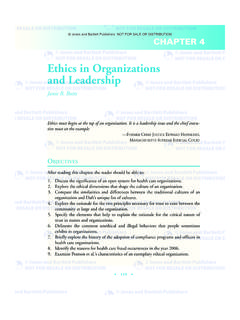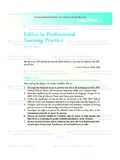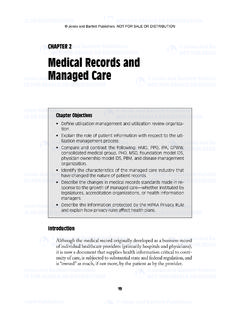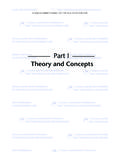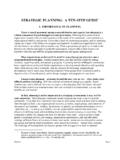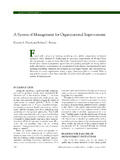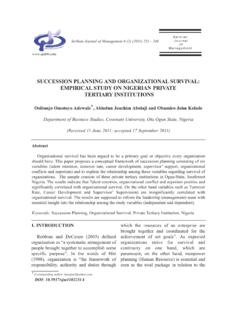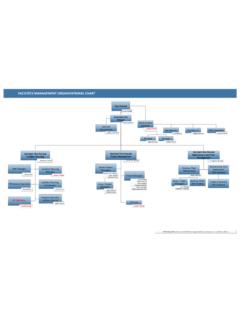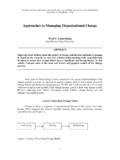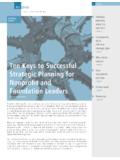Transcription of Today’s Concept of Organizational Management
1 7/25/07 3:12 PM Page 51. Jones and Bartlett Publishers. NOT FOR SALE OR DISTRIBUTION. C HAPTER. 3. Today's Concept of Organizational Management CHAPTER OBJECTIVES. Define Management and differentiate between the art and science of Management . Review the basic functions of Management . Describe the major phases of the development of Organizational Management . Present the Concept of the work setting as a total system. Introduce the Concept of clientele network and describe the appli- cation of this Concept to the health care setting. T H E N AT U R E O F M A N A G E M E N T: A RT O R S C I E N C E ? Management has been defined as the process of getting things done through and with people.
2 It is the planning and directing of effort and the organizing and em- ploying of resources (both human and material) to accomplish some predetermined objective. Within the overall Concept of Management , the function of adminis- tration can be identified. The practical execution of the plans and decisions on a day-to-day basis requires specific administrative activities that managers may assign 51. 7/25/07 3:12 PM Page 52. Jones and Bartlett Publishers. NOT FOR SALE OR DISTRIBUTION. 52 C HAPTER 3 T ODAY ' S C ONCEPT OF O RGANIZATIONAL M ANAGEMENT. to executive officers or administrators. Managers may find that their role includes specifically administrative activities in addition to overall Management responsi- bilities.
3 The workday of a typical department head in a health care institution con- tains a mix of broad-based managerial functions and detailed administrative actions. Especially since the turn of the 20th century, Management 's scientific aspects have been emphasized. The scientific nature of Management is reflected in the fact that it is based on a more or less codified body of knowledge consisting of theories and principles that are subject to study and further experimentation. Yet, man- agement as a science lacks the distinct characteristics of an exact discipline, such as chemistry or mathematics. The many variables associated with the human element make Management as much an art as a science.
4 Even with complex analytical tools for decision making, such as probability studies, stochastic (random) simulation, and similar mathemat- ical elements, the manager must rely on intuition and experience in assessing such factors as timing and tactics for persuasion. FUNCTIONS OF THE MANAGER. A manager's functions can be considered a circle of actions in which each com- ponent leads to the next. Although the functions can be identified as separate sets of actions for purposes of analysis, the manager in actual practice carries out these activities in a complex, unified manner within the total process of managing. Other individuals in the organization carry out some of these activities, either periodically or routinely, but the manager is assigned these specific activities in their entirety, as a continuing set of functions.
5 When these processes become routine, the role of manager emerges. The traditional functions of a manager were identified by Gulick and Urwick1 based on the earlier work of Henri Chester Barnard brought together the significant underlying premises about the role of the manager in his classic work The Functions of the Classic Management Functions Management functions typically include planning the selection of objectives, the establishment of goals, and the factual determination of the existing situation and the desired future state. decision making a part of the planning process in that a commitment to one of several alternatives (decisions) must be made.
6 Others may assist in plan- 7/25/07 3:12 PM Page 53. Jones and Bartlett Publishers. NOT FOR SALE OR DISTRIBUTION. FUNCTIONS OF THE MANAGER 53. ning, but decision making is the privilege and burden of managers. Decision making includes the development of alternatives, conscious choice, and commitment. organizing the design of a pattern of roles and relationships that contribute to the goal. Roles are assigned, authority and responsibility are determined, and provision is made for coordination. Organizing typically involves the development of the organization chart, job descriptions, and statements of work flow. staffing the determination of personnel needs and the selection, orientation, training, and continuing evaluation of the individuals who hold the required positions identified in the organizing process.
7 (Some theorists class the staffing function within the organizing function, rather than viewing it as a separate function.). directing or actuating the provision of guidance and leadership so that the work performed is goal-oriented. It is the exercise of the manager's influence, the process of teaching, coaching, and motivating workers. controlling the determination of what is being accomplished, the assess- ment of performance as it relates to the accomplishment of the Organizational goals, and the initiation of corrective actions. In contemporary Management practice, the larger concepts of performance improvement and total quality Management include controlling.
8 Figure 3 1 summarizes the classic functions of managers and their relationship to each other. In addition, managers must continually establish and maintain in- ternal and external Organizational relationships to achieve an effective working rapport. They must monitor the organization's environment to anticipate change and bring about the adaptive responses required for the institution's survival. At different phases in the life of the organization, one or another Management function may be dominant. In the early stages of Organizational development, for example, planning is the manager's primary function. When the organization is mature, however, controlling functions are emphasized.
9 The Health Care Practitioner as Manager In the specialized environment of a health care institution, qualified professional practitioners may assume the role of unit supervisor, project manager, or depart- ment head or chief of service. The role may emerge gradually as the number of patients increases, as the variety of services expands, and as specialization occurs 7/25/07 3:12 PM Page 54. Jones and Bartlett Publishers. NOT FOR SALE OR DISTRIBUTION. 54 C HAPTER 3 T ODAY ' S C ONCEPT OF O RGANIZATIONAL M ANAGEMENT. Achieving the Objective Controlling Planning measuring accomplishments identifying goals & objectives against stated goals stating premises & assumptions correcting deviations from goals developing specific.
10 Detailed plans developing feedback mechanisms Actuating/Motivating Organizing communicating objectives to members breaking work down into components leading members to objectives grouping related work activities & units training and supervising defining authority relationships integrating individuals into organization developing organization chart developing position descriptions FIGURE 3 1 Interrelationship of Management Functions within a profession. A physical therapy staff specialist, for example, may develop a successful program for patients with spinal cord injury; as the practitioner most directly involved in the work, this individual may be given full administrative re- sponsibility for that unit.
